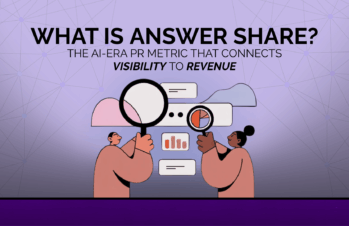Most B2Bs chase tier-one press hits. Who could blame them for coveting the likes of the Wall Street Journal, Forbes, or Inc. Magazine? But the truth is that this strategy is flawed. Sure, a top-tier publication is a great win—celebrate that when it happens. But smaller publications are incredibly effective for extending the reach of your brand and making yourself known. Long-tail B2B marketing and PR will yield consistent wins across channels. Here’s what we mean.
What is long-tail PR?
In a sentence: Long-tail PR is the effort of securing multiple niche PR hits in smaller publications rather than a few powerful tier-one hits. Think of it like a forest: 100-year-old oak trees sure pack a visual punch, but the moss on the forest floor covers much more ground and produces more oxygen than the trees. Okay, so you didn’t come here for a forestry lesson, but you get the point: the goal is to generate many small hits that support the grassroots connection between brands and audiences. A smaller, engaged audience is always better than a larger, disengaged one. And many smaller hits mean higher SEO returns and value far beyond the publication date.
Tier-One Hits versus Long-Tail PR: Netflix versus YouTube
Need further convincing that long-tail PR is more effective? Just ask YouTube. Both Netflix and YouTube are $30-billion media companies—but with two very different strategies. Netflix invests in big hits. They spend billions on shows like Stranger Things, Squid Game, and so on.
YouTube takes the exact opposite strategy: the long-tail approach. When you invest in a lot of “niche” or “smaller opportunities” rather than bet on one or two big bestsellers, blockbusters, or PR hits, you increase your overall share of voice (SOV) in the market. Tier-one press hits are great, but you should actually be investing in long-tail PR if you are hoping to use earned media to drive your brand and business forward—which you should be.
If you are a tech-driven B2B, then you should be doing these two things:
- Using long-tail PR to build share of voice
- Leveraging the earned media from long-tail PR to get an even longer tail
Increasing Your Share of Voice with Long-Tail PR
Share of voice, in its simplest definition, is how many people are aware of your brand. So how can long-tail PR make more people aware of your brand? Simply, it keeps giving value. The best result of a long-tail PR strategy is a hit that reaches its peak performance after the publication date—or at least it keeps its performance up for quite some time. The more eyeballs on your press hit, the longer the tail grows. Kind of like a Pinocchio’s nose situation. And this strategy also doesn’t come with any strings attached—save that you refocus your attention from the big outlets to smaller, industry-specific, and audience-niche publications. If you want to be successful with long-tail PR, you must say yes to that podcast, yes to that newsletter, and yes to that trade publication.
This doesn’t mean that you can’t go after tier-one opportunities. It simply means that you will have a lot more success if you focus on building your overall SOV rather than chasing one-off placements.
Related Reading: Why B2Bs Need to Invest Big in Share of Voice, According to Data
Leveraging Earned Media with Long-Tail PR
Every time your brand gets a press hit, you should be amplifying it. When you focus on your efforts on tier-one press hits alone, you expend a lot more of your resources for one hit than you would for many smaller ones. And even though you can still amplify that single hit—increasing its tail—it is a much more effective strategy to have many smaller hits that you can continuously amplify. Nothing can get stale if you are amplifying one piece of content through a soundbite, quote card, or video snippet on one platform and then sharing a new hit with your audience on another platform. The cycle of new long-tail, niche PR hits merges with the amplification cycle, and the result is an ever-presence of your brand in the headlines.
If a prospect doesn’t know you, they can’t do business with you. On average, it takes five to seven impressions for someone to remember your brand (and 27 touchpoints to make a sale). As you make those impressions, you increase your brand visibility. That visibility creates frequency bias, which builds trust with your audience. And building trust moves prospects down the sales funnel toward the next touchpoints.
Related Reading: Your PR isn’t Cutting It: S.A.M. Can Help
Long-tail PR can even be hyperlocal. Imagine you are planning a tech networking event with a panel discussion and you want an effective way to generate interest and get the attention of the people who are most likely to attend. Getting a hit in a regional newspaper, in this case, may be too “tier-one” for the event. It has a broader market, yes, but are your techie audiences really reading the newspaper listings to find out where their next big event is going to be? Probably not.
Instead, a better strategy could be to get in the email newsletter of a local tech association, on the LinkedIn page of a local tech leader, and in a Discord chat of local programmers. This strategy goes deeper than a single press hit could go and can even have a greater influence in dark social channels—a huge bonus.
How do you create a long-tail marketing strategy?
There are three key components to building and executing a long-tail marketing strategy.
- Position yourself as a resource.
Your audience is niche. They likely know the basics of your industry or topics. So become a resource for them. Educate. Entertain. Share insights and make content that is specific and unique. Provide value for your audience where they are, and they will remember you.
- Target many small, niche publications over tier-one outlets.
In the Netflix versus YouTube analogy, you want to follow YouTube’s path. Invest your time in opportunities that may seem small but are plenty. Remember, you need five to seven touchpoints to be remembered and 27 to make a sale!
- Share evergreen content.
While, of course, you are going to have time-sensitive content (like that tech networking event from earlier), if you make yourself newsworthy and share your insights (i.e., build your thought leadership platform) with podcasters, bloggers, and TikTokers, you’ll be able to distill evergreen content into your interviews. Not only does it further lengthen the tail of your long-tail PR, but it makes amplification a breeze.
Related Reading: The Ultimate Guide to B2B PR
Ready to see real results from your PR efforts? Invest in long-tail PR. Want a little help kickstarting your campaign? Let’s chat. This is kind of our thing.




